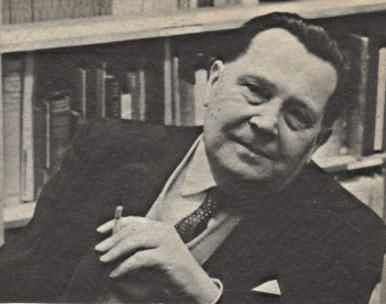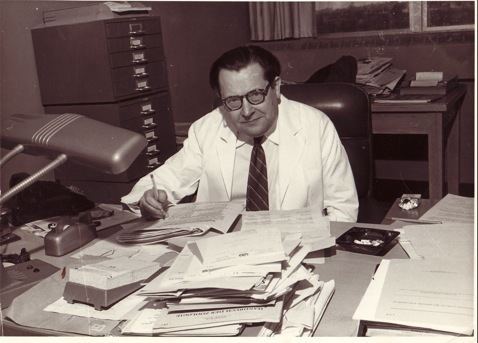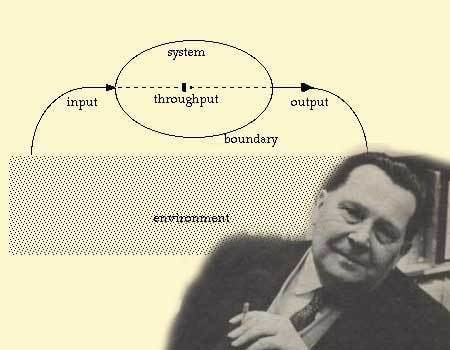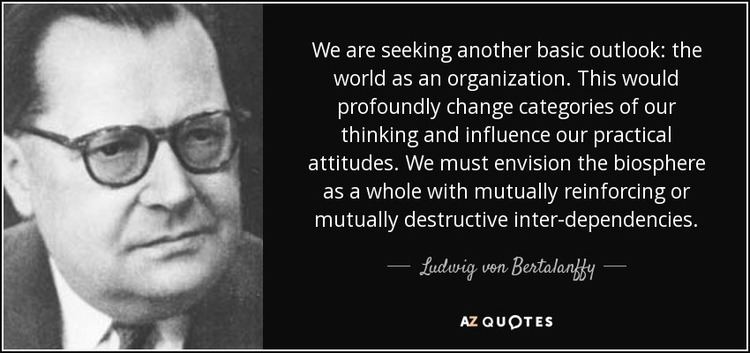Name Ludwig Bertalanffy | Known for Systems theory | |
 | ||
Influenced Russell L. Ackoff, Kenneth E. Boulding, Peter Checkland, C. West Churchman, Jay Wright Forrester, Ervin Laszlo, James Grier Miller, Anatol Rapoport Parents Gustav von Bertalanffy, Charlotte Vogel Similar People Norbert Wiener, Moritz Schlick, Jay Wright Forrester, Rudolf Carnap, C West Churchman | ||
Karl Ludwig Von Bertalanffy (teoria general de sistemas)
Karl Ludwig von Bertalanffy (September 19, 1901 – June 12, 1972) was an Austrian biologist known as one of the founders of general systems theory (GST). This is an interdisciplinary practice that describes systems with interacting components, applicable to biology, cybernetics and other fields. Bertalanffy proposed that the classical laws of thermodynamics applied to closed systems, but not necessarily to "open systems," such as living things. His mathematical model of an organism's growth over time, published in 1934, is still in use today.
Contents
- Karl Ludwig Von Bertalanffy teoria general de sistemas
- Biography
- Family life
- Work
- Individual growth model
- Bertalanffy equation
- Bertalanffy module
- General system theory
- Open systems
- Systems in the social sciences
- Publications
- References

Bertalanffy grew up in Austria and subsequently worked in Vienna, London, Canada, and the USA.

Biography
Ludwig von Bertalanffy was born and grew up in the little village of Atzgersdorf (now Liesing) near Vienna. The Bertalanffy family had roots in the 16th century nobility of Hungary which included several scholars and court officials. His grandfather Charles Joseph von Bertalanffy (1833–1912) had settled in Austria and was a state theatre director in Klagenfurt, Graz and Vienna, which were important sites in imperial Austria. Ludwig's father Gustav von Bertalanffy (1861–1919) was a prominent railway administrator. On his mother's side Ludwig's grandfather Joseph Vogel was an imperial counsellor and a wealthy Vienna publisher. Ludwig's mother Charlotte Vogel was seventeen when she married the thirty-four-year-old Gustav. They divorced when Ludwig was ten, and both remarried outside the Catholic Church in civil ceremonies.

Ludwig von Bertalanffy grew up as an only child educated at home by private tutors until he was ten. When he arrived at his Gymnasium (a form of grammar school) he was already well habituated in learning by reading, and he continued to study on his own. His neighbour, the famous biologist Paul Kammerer, became a mentor and an example to the young Ludwig.

In 1918, Bertalanffy started his studies at the university level in philosophy and art history, first at the University of Innsbruck and then at the University of Vienna. Ultimately, Bertalanffy had to make a choice between studying philosophy of science and biology; he chose the latter because, according to him, one could always become a philosopher later, but not a biologist. In 1926 he finished his PhD Thesis (translated title: "Fechner and the problem of integration of the higher order") on the psychologist and philosopher Gustav Theodor Fechner. For the next six years he concentrated on a project of “theoretical biology,” which focused on the philosophy of biology. He received his habilitation in 1934 in “theoretical biology”.

Bertalanffy was appointed Privatdozent at the University of Vienna in 1934. The post yielded little income, and Bertalanffy faced continuing financial difficulties. He applied for promotion to the status of associate professor, but funding from the Rockefeller Foundation enabled him to make a trip to Chicago in 1937 to work with Nicolas Rashevsky. He was also able to visit the Marine Biological Laboratory in Massachusetts.
Bertalanffy was still in the US when he heard of the Anschluss in March 1938. However, his attempts to remain in the US failed, and he returned to Vienna in October of that year. Within a month of his return, he joined the Nazi Party, which facilitated his promotion to professor at the University of Vienna in 1940. During the Second World War, he linked his “organismic” philosophy of biology to the dominant Nazi ideology, principally that of the Führerprinzip.
Following the defeat of Nazism, Bertalanffy found denazification problematic and left Vienna in 1948. He moved to the University of London (1948–49); the Université de Montréal (1949); the University of Ottawa (1950–54); the University of Southern California (1955–58); the Menninger Foundation (1958–60); the University of Alberta (1961–68); and the State University of New York at Buffalo (SUNY) (1969–72).
In 1972, he died from a sudden heart attack.
Family life
Bertalanffy met his wife, Maria, in April 1924 in the Austrian Alps. They were hardly ever apart for the next forty-eight years. She wanted to finish studying but never did, instead devoting her life to Bertalanffy's career. Later, in Canada, she would work both for him and with him in his career, and after his death she compiled two of Bertalanffy's last works. They had one child, a son who followed in his father's footsteps by making his profession in the field of cancer research.
Work
Today, Bertalanffy is considered to be a founder and one of the principal authors of the interdisciplinary school of thought known as general systems theory. According to Weckowicz (1989), he "occupies an important position in the intellectual history of the twentieth century. His contributions went beyond biology, and extended into cybernetics, education, history, philosophy, psychiatry, psychology and sociology. Some of his admirers even believe that this theory will one day provide a conceptual framework for all these disciplines". Spending most of his life in semi-obscurity, Ludwig von Bertalanffy may well be the least known intellectual titan of the twentieth century.
Individual growth model
The individual growth model published by Ludwig von Bertalanffy in 1934 is widely used in biological models and exists in a number of permutations.
In its simplest version the so-called Bertalanffy growth equation is expressed as a differential equation of length (L) over time (t):
when
The Dynamic Energy Budget theory provides a mechanistic explanation of this model in the case of isomorphs that experience a constant food availability. The inverse of the Bertalanffy growth rate appears to depend linearly on the ultimate length, when different food levels are compared. The intercept relates to the maintenance costs, the slope to the rate at which reserve is mobilized for use by metabolism. The ultimate length equals the maximum length at high food availabilities.
Bertalanffy equation
The Bertalanffy equation is the equation that describes the growth of a biological organism. The equation was offered by Ludwig von Bertalanffy in 1969.
Here W is organism weight, t is the time, S is the area of organism surface, V is a physical volume of the organism.
The coefficients
The solution of the Bertalanffy equation is the function:
where
Bertalanffy module
To honor Bertalanffy, ecological systems engineer and scientist Howard T. Odum named the storage symbol of his General Systems Language as the Bertalanffy module (see image right).
General system theory
The biologist is widely recognized for his contributions to science as a systems theorist; specifically, for the development of a theory known as general system theory (GST). The theory attempted to provide alternatives to conventional models of organization. GST defined new foundations and developments as a generalized theory of systems with applications to numerous areas of study, emphasizing holism over reductionism, organism over mechanism.
Foundational to GST are the inter-relationships between elements which all together form the whole.
Open systems
Bertalanffy's contribution to systems theory is best known for his theory of open systems. The system theorist argued that traditional closed system models based on classical science and the second law of thermodynamics were inadequate for explaining large classes of phenomena. Bertalanffy maintained that “the conventional formulation of physics are, in principle, inapplicable to the living organism being open system having steady state. We may well suspect that many characteristics of living systems which are paradoxical in view of the laws of physics are a consequence of this fact.” However, while closed physical systems were questioned, questions equally remained over whether or not open physical systems could justifiably lead to a definitive science for the application of an open systems view to a general theory of systems.
In Bertalanffy’s model, the theorist defined general principles of open systems and the limitations of conventional models. He ascribed applications to biology, information theory and cybernetics. Concerning biology, examples from the open systems view suggested they “may suffice to indicate briefly the large fields of application” that could be the “outlines of a wider generalization;” from which, a hypothesis for cybernetics. Although potential applications exist in other areas, the theorist developed only the implications for biology and cybernetics. Bertalanffy also noted unsolved problems, which included continued questions over thermodynamics, thus the unsubstantiated claim that there are physical laws to support generalizations (particularly for information theory), and the need for further research into the problems and potential with the applications of the open system view from physics.
Systems in the social sciences
In the social sciences, Bertalanffy did believe that general systems concepts were applicable, e.g. theories that had been introduced into the field of sociology from a modern systems approach that included “the concept of general system, of feedback, information, communication, etc.” The theorist critiqued classical “atomistic” conceptions of social systems and ideation “such as ‘social physics’ as was often attempted in a reductionist spirit.” Bertalanffy also recognized difficulties with the application of a new general theory to social science due to the complexity of the intersections between natural sciences and human social systems. However, the theory still encouraged for new developments from sociology, to anthropology, economics, political science, and psychology among other areas. Today, Bertalanffy's GST remains a bridge for interdisciplinary study of systems in the social sciences.
Publications
The first articles from Bertalanffy on General Systems Theory:
